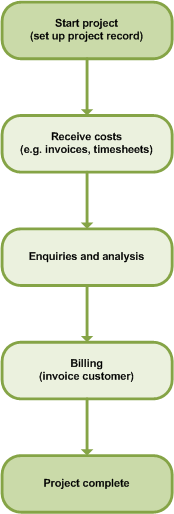Project life cycle
The typical life cycle of a project can be categorised into three stages:
- The setup stage.
- The active stage.
- The completion stage.
Setup stage
The first stage is the creation of the project.
- Create the project from scratch. Do this from a template, from an existing project, or from a quotation or sales order.
- Use the project record to store additional information, milestones and the project activities.
Active stage
The second stage covers the time when resources and costs are still being incurred, up until the project has been completed.
-
Record costs and revenues.
Place orders, invoices and credit notes, stock issues and returns, payments, timesheets, expense claims and miscellaneous costs.
-
Record the details of any activity
For example, this could be hours of work or units of stock. These affect the cost of your project. The costs are entered against activities and are used as the basis for billing the project.
-
Project enquiries and reports.
Use enquiries and reports to analyse the progress of your project and its costs, revenues, and profitability.
-
Project billing.
Create invoices and credit notes for your project customers.
Completion stage
The third stage represents the completion of a project.
- Mark the project status as complete.

